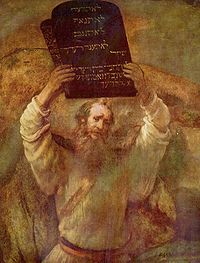Egyptian Mythology
 From Conservapedia
From Conservapedia Egyptian mythology includes all the religious beliefs practiced by ancient Egyptians. These beliefs greatly influenced the development of their culture, but there was never a unified theological system. The Egyptian faith was based on a collection of ancient myths, nature worship, and a number of deities.[1]
Deities[edit]
Amun/Amun-Ra was the supreme state god of the New Kingdom, a Theban god, "mysterious of form" and associated with the wind who rode to greatness following the rise to prominence of his home city, and his association with the powerful sun god, Ra.
Anubis was the god of embalming and was often represented by a jackal or other dog, his brother is Horus.
Horus is the Egyptian sky god who is often represented by the falcon, he said to have resurrected his dead father Osiris. Pharaohs were supposedly reincarnations of this god.
Iah is an Ancient Egyptian lunar god, whose role was linked to that of Thoth in the Old and Middle Kingdoms, and who came to be eclipsed to some degree by Khonsu from the New Kingdom onward. Some scholars regard the god as the personification of the lunar disc itself within Ancient Egyptian culture.
Imhotep was originally an historic figure but was later deified by the Egyptians into the god of medicine. In his mortal history he was credited with the design of the step pyramid.
Isis is a goddess who is supposed to be the wife of Osiris and (in later times) the mother of Horus.
Ma'at The concept of divine order, justice and that which is right, upon which the universe is based. As a goddess, the daughter of Ra and consort of Thoth.
Neith An archaic goddess of war and hunting, and one of the oldest Egyptian gods, with cult centres in Sais and Esna. Associated by the Greeks with Athena.
Nekhbet is a vulture goddess, protectress of the Pharaoh, along with Wadjet, and patron goddess of Upper Egypt.
Osiris is a god who was said to have been killed by his brother the god Set, only to be resurrected by his son Horus.
Ra is the supreme manifestation of the Egyptian sun god of Heliopolis and one of the most important members of the Ancient Egyptian pantheon. The Egyptians believed that each day the sun was reborn. In the morning after a bath and breakfast he took a journey across the sky in his heavenly boat and would spend an hour of each day inspecting each of his 12 provinces. When the sun went down in the evening Ra was believed to enter the underworld until the next morning. All night long Ra had to fight his enemy Apep the terrible cosmic serpent who lived in the underworld. Ra is usually depicted as a falcon wearing a sun disc on his head. The rulers of Ancient Egypt called themselves Pharaohs - literally "Sons of Ra" - as a means of establishing their divinity.
Seshat is a goddess of writing and measuring and the scribal arts, predating Thoth. Her name literally translates as “The Female Scribe”, and in later times she was regarded as a husband or sister of Thoth.
Set is the brother of Osiris and uncle of Horus, he is said to have killed Osiris, who was later resurrected by Horus, Set was then killed by Horus.
Thoth was an Egyptian god represented with the head of an ibis, who was supposed to make sure neither good nor bad had too much power over the other.
References[edit]
- ↑ http://www.emayzine.com/lectures/egyptian.htm
| ||||||||||||||||||||||||||||||||||||||
Categories: [Mythology] [Egypt] [Ancient Egypt]
↧ Download as ZWI file | Last modified: 03/20/2023 19:25:19 | 31 views
☰ Source: https://www.conservapedia.com/Egyptian_mythology | License: CC BY-SA 3.0
 ZWI signed:
ZWI signed:
 KSF
KSF